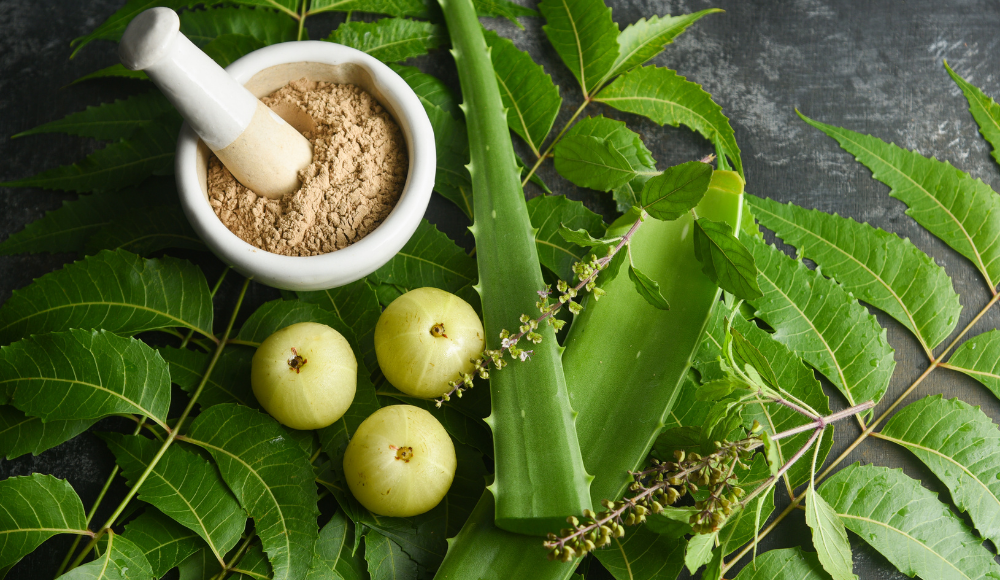Ayurveda makes extensive use of dietary methods for disease prevention, palliative treatments such as oil massage, purification treatments such as Panchakarma, and herbal preparations for the treatment of various illnesses. Thus, herbal preparations occupy a central role in Ayurveda.
Herbal preparations are comprehensive pharmaceutical sciences and are the result of wisdom born from many years of clinical experience. In recent years, its physiological effects have been scientifically verified. This time, we will explain in detail the relationship between Ayurveda and herbal preparations.
What is Ayurveda?
Ayurveda is the "science of longevity" with a history of over 5,000 years in India. It is the source of world medicine and is an advanced whole body medical system that combines ancient Indian civilization and indigenous medicine. In the West, it was introduced to Western medicine through Greek medicine and Yunani medicine, and in the East, it was introduced to Japanese Buddhist medicine through Chinese medicine.
Ayurveda is characterized by the idea that disease prevention is better than disease treatment. In addition, we adopt the concept of whole body medicine and emphasize harmonizing the vital functions of the whole body, rather than focusing only on the functions of a particular part of the body. Therefore, we believe that it is necessary to consider all factors such as physical and mental physiological conditions, lifestyle, and environment in order to maintain health.
Ayurveda is also an expert in medicine and makes extensive use of advanced herbal preparations for disease prevention and treatment. To determine health status, we make full use of a unique disease theory called the "tri-dosha theory." This is an application of the triguna theory and five element theory of Samkhya philosophy, which is the basis of Indian thought, to the determination of the physiological functions of the human body, and has been inherited in traditional medicine around the world.
Relationship between Ayurveda and herbs
Herb in Ayurveda refers to any part of a plant. Main uses include medicinal herbs, spices, perfume oils, and food ingredients.
Herbs have been used since prehistoric times, and Ayurveda in particular has developed a sophisticated and systematic herbalism. Herbal applications are the backbone of Ayurveda and are widely used in the prevention and treatment of diseases. The main reason for this is that the diverse climate and topography of the Indian subcontinent produces a rich variety of medicinal plants.
Medicinal efficacy of herbs and usage rate in the world
Ayurvedic doctors have patiently investigated and researched the medicinal properties of approximately 10,000 herbs from thousands of years ago to the present day. Ask the herb about the best time to collect herbs. Herbal preparations are a combination of herbs whose effectiveness has been confirmed through clinical trials, and approximately 8,000 herbal remedies are registered with India's Ministry of Traditional Medicine (AYUSH).
In recent years, scientific research on pharmacological effects has progressed rapidly, and data is being compiled mainly in India. The World Health Organization (WHO) points out that approximately 20,000 plant species can be used as medicinal plants. In fact, 80% of the world's people rely on herbal preparations to manage their health.
In developed countries in Europe and America, herbal preparations account for 25%, and in India, China, and developing countries, herbal preparations account for 80%. Seventy percent of the effective drugs in Western medicine are derived from plants, and plant ingredients are important starting materials (lead compounds) for drug manufacturing.
Uses and benefits of herbal preparations
Ayurvedic herbal preparations are used in many ways, such as:
- longevity
- adult disease
- trauma
- Analgesics
- Detoxification/purification
- Infection
- fever reduction
- Internal organs diseases (acute & chronic)
- Preservative
- tonic
- dewormer
The advantage of herbal preparations is that they are effective in treating many visceral diseases, adult diseases, neurological diseases, and intractable diseases that are difficult to treat with synthetic drugs. In recent years, the identification of active ingredients has progressed, and their mechanisms of action are being scientifically elucidated.
The active ingredients are plant secondary metabolites, which are organic compounds with a wide variety of structures. Their chemical structures are diverse and involve complex synthetic routes, including terpenoids, flavonoids, and polyphenols.
Since plants cannot move, they interact with animals, insects, microorganisms, and plants through a variety of secondary metabolites, and they also have defenses against parasitoids and predators, attracting symbionts, securing habitat, and protecting against cold heat and ultraviolet rays. doing.
Misconceptions about herbal preparations
Herbal preparations are said to have fewer side effects, but this is a pharmaceutical manufacturing technology acquired through many years of experience. Herbs are basically poisonous and unsafe. It's just the dosage and combination of herbs that eliminates the side effects.
Traditionally, herbal preparations have been used to compensate for the shortcomings of synthetic chemicals in Western medicine. Advantages of herbal preparations included low cost, stable supply, safety, and resistance to habit-forming and tolerance mechanisms.
In recent years, it has been demonstrated that the performance of herbal preparations as pharmaceuticals is superior to synthetic drugs. In the field of health and longevity science, the effectiveness of herbal preparations has been well proven. It far outperforms chemicals, except that producing and supplying good quality herbal preparations is not easy. Blind reliance on chemicals is over, and the usefulness of herbal preparations is being recognized once again.
constitution and herbs
Ayurveda always considers the body's constitution (prakriti) when performing treatments to maintain health or treat illnesses. If these treatments do not suit your constitution, their effectiveness will be reduced by half, and they may even have the opposite effect.
Ingesting herbs is the most effective way to improve your constitution. According to Ayurvedic literature, 29 herbs are recommended for improving Vata constitutions, 37 for Pitta constitutions, and 69 for Kapha constitutions.
Why there are three types of constitution: Vata, Pitta, and Kapha
Ayurveda emphasizes three types of constitution (prakriti).
- vata
- pitta
- Kapha
We believe that the balance of expression of three homologous genes (similar genes that perform the same function) involved in early development determines a person's constitution. For convenience, these are called "constitutional genes."
Vata constitution refers to a person in whom the expression of constitutional genes that define Vata constitution is predominant. Constitution reflects the expression pattern of three constitutional genes at birth. This expression pattern is determined by the in utero environment and is thought to be non-inheritable.
The fact that people have different constitutions is thought to be the mechanism that creates human diversity. In Ayurveda, it is said that if you are born with a constitution, if you ignore it, it will become even more biased. This increases diversity across humanity, but at the cost of individual health.
Even during the aging process, our constitution becomes biased. Considering health and longevity, it is desirable to return the expression pattern of constitutional genes to the ideal form (Vata, Pitta, and Kapha constitutions are equally expressed) as much as possible. Ayurveda shows that our constitution can be improved through proper diet, lifestyle changes, and appropriate use of herbs.
The use of herbs is the best way to improve your constitution, but there are some limitations. It is difficult to obtain high-quality herbs, and creating herbal preparations requires specialized knowledge.
In Japan, there are regulations under the Pharmaceutical and Medical Device Law. Foreign products such as those made in India and the United States lack safety and reliability. Therefore, only a limited number of herbs are used in Europe and America.
Foods recommended for Vata (wind)
The attribute of Vata constitution is “air”. It is characterized by ``unstable,'' ``cold,'' and ``dry,'' so herbs that calm, warm, moisturize, and aid digestion are effective.
In Europe and America, the following are used:
- ginger
- fennel
- chamomile
- ashwagandha
- Triphala
Eating a diet that soothes Vata is also effective in improving your constitution. Regarding ingredients, Ayurveda offers the following guidelines:
- grain
- vegetables
- meat
- beans
- spices
- sweet fruit
- dairy products
- oils
However, it is not realistic to create a meal menu that suits the constitution of the entire family. Therefore, the following simple diet is recommended.
- Avoid what you like and eat what you don't like
- Avoid spiciness, bitterness, and astringency, and eat more sour, hydrochloric, and salty tastes.
- Avoid light, cold foods, which are characteristic of Vata constitution, and eat warm, heavy foods, which are the opposite.
Foods recommended for pitta (fire)
The attribute of Pitta constitution is "fire". It is characterized by passion, criticism, and inflammation, so herbs that calm the mind and body and relieve inflammation are effective.
In Europe and America, the following are used:
- coriander
- mint
- rose
- shatavari
- Triphala
Additionally, there are three dietary methods to soothe Pitta:
- Avoid what you like and eat what you don't like
- Avoid sour, salty, and spicy tastes, and eat sweet, bitter, and astringent tastes.
- Avoid hot, spicy foods, which are characteristic of Pitta constitution, and eat more cold, sweet foods, which are the opposite.
Foods recommended for Kapha (water)
The attribute of Kapha constitution is "water". Characterized by moist, cold, and obese, you can find a balance of drying, warming, and mildly tonic herbs that "ignite" the fire in your digestive system. Light, warm, aromatic herbs work well. In Europe and America,
- turmeric
- ginseng
- Triphala
- black pepper
etc. are famous.
There are three ways to eat to soothe Kapha:
- Avoid what you like and eat what you don't like
- Avoid sour, sour, and salty tastes, and eat spiciness, bitterness, and astringency.
- Avoid heavy, oily foods, which are characteristic of a kapha constitution, and eat more light, less oily foods, which are the opposite.
summary
Explained the relationship between Ayurveda and herbs.
The existence of three types of body types among mammals is thought to be due to the ability of the species to adapt to the external environment. Diversity in biological functions increases the chance of adapting to environmental changes, and this comes at the expense of individual health.
In order for a species to survive, the survival principle of the group takes precedence, and the survival of individual members is secondary. In a human society that emphasizes individual profit, how to improve one's physical constitution is an important issue.
Besides expressing your personality, your constitution also influences your susceptibility to certain diseases and your health span. Ayurveda presents various ways to improve the constitution and provides a method for achieving a long and healthy life equally for all people. It is desirable for each person to understand their own constitution well and learn how to improve their constitution and live a long and healthy life.
Ayurmaster sells health supplements, beverages, and beauty products related to Ayurveda. Please check this product page for more details.

